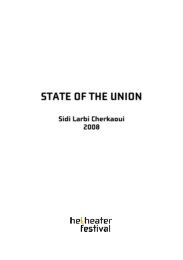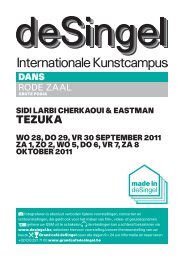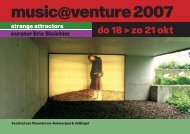Programmaboekje : Wonen in welvaart - deSingel
Programmaboekje : Wonen in welvaart - deSingel
Programmaboekje : Wonen in welvaart - deSingel
You also want an ePaper? Increase the reach of your titles
YUMPU automatically turns print PDFs into web optimized ePapers that Google loves.
The exhibition<br />
The exhibit br<strong>in</strong>gs forward a number of important factors <strong>in</strong>volved<br />
<strong>in</strong> the <strong>in</strong>crease of liv<strong>in</strong>g comforts through a dozen case studies<br />
from recent fi nd<strong>in</strong>gs: the <strong>in</strong>centive system De Taeye of 1948,<br />
the hous<strong>in</strong>g exhibits of the Farmers’ Wives Association and the<br />
Christian Workers’ Wives, the ready-to-use offer of a build<strong>in</strong>g<br />
<strong>in</strong>vestor, but also ‘model operations’ like the Modelwijk (the model<br />
district) of Renaat Braem for the world exhibition <strong>in</strong> 1958 or the<br />
satellite town Nieuw Sledderlo <strong>in</strong> Genk. The exhibition widens the<br />
perspective and looks how new ideas about hous<strong>in</strong>g from Belgium<br />
had the ambition of solv<strong>in</strong>g the world wide hous<strong>in</strong>g shortage.<br />
Typical examples are the Offi ce des Cités Africa<strong>in</strong>es (OCA) and<br />
the hous<strong>in</strong>g models of the eng<strong>in</strong>eer Georges Patfoort. Every<br />
elaborated case study br<strong>in</strong>gs together a rich selection of archives’<br />
material from various collections such as architectural archives,<br />
companies’ archives and images from private collections. Thus,<br />
the exhibition gives an overview of a number of hous<strong>in</strong>g models<br />
that were decisive for the postwar hous<strong>in</strong>g culture, and the way <strong>in</strong><br />
which they were documented <strong>in</strong> several archives.<br />
1)<br />
The De Taeye Act (1948)<br />
The <strong>in</strong>dividual home as the cornerstone of the welfare state<br />
The fi rst big hous<strong>in</strong>g law after World War II was the De Taeye<br />
Act, that refl ected the catholic vision on the role of the state<br />
<strong>in</strong> hous<strong>in</strong>g. It featured <strong>in</strong>centives for build<strong>in</strong>g new houses by<br />
private <strong>in</strong>dividuals and a state guarantee for private loans from<br />
acknowledged credit companies. The purpose of the law was to<br />
respond to the shortage of modest homes, and at the same time<br />
to boost the build<strong>in</strong>g <strong>in</strong>dustry. Until 1960, the De Taeye Act did not<br />
impose an <strong>in</strong>come limit, <strong>in</strong>stead it defi ned maximum surfaces fi t<br />
for hous<strong>in</strong>g.<br />
The De Taeye Act was a big success <strong>in</strong> Flanders. In 1954 the<br />
100.000th <strong>in</strong>centive bonus was celebrated gloriously. Almost<br />
a third of postwar hous<strong>in</strong>g was realized with the help of the<br />
<strong>in</strong>centive. In the fi fties it were mostly terraced houses.<br />
In comb<strong>in</strong>ation with the advent of the car, the De Taeye Act led<br />
to a spatial growth that caused several villages to come apart<br />
at the seams. New houses weren’t built <strong>in</strong> the village cores or<br />
the city centres, but were spread over the whole surface: at the<br />
borders, as ribbon build<strong>in</strong>g along the exist<strong>in</strong>g access roads and as<br />
semidetached or detached houses <strong>in</strong> new districts.<br />
(research: Katrien Theunis)<br />
2)<br />
The National Agency for Small Private Property<br />
Model plann<strong>in</strong>g for the countryside <strong>in</strong> the fi fties<br />
Already before World War II, two national build<strong>in</strong>g companies<br />
were responsible for public hous<strong>in</strong>g. The National Agency for<br />
Cheap Hous<strong>in</strong>g and Accomodation (NMGWW) built especially<br />
<strong>in</strong> urban districts whereas the National Agency for Small Private<br />
Property (NMKL) was ma<strong>in</strong>ly active <strong>in</strong> countryside districts and<br />
also built houses for sale. After the Brunfaut Act of 1949 that<br />
regulated the fi nanc<strong>in</strong>g of social hous<strong>in</strong>g, their activities <strong>in</strong>creased<br />
perceptibly. The NMKL was at the crossroads of social hous<strong>in</strong>g and<br />
the private market: with the <strong>in</strong>centive premiums of the De Taeye<br />
Act people were able to buy a NMKL-house.<br />
The deliberate strategy of the NMKL was to spread cheap houses<br />
over the entire countryside. It was supposed to tie labourers to the<br />
land they were liv<strong>in</strong>g on. Furthermore the people would be able<br />
to have a vegetable garden for a ra<strong>in</strong>y day. The districts that arose<br />
everywhere <strong>in</strong> Flanders were the expression of a desire to live out<br />
of town and to be self-suffi cient.<br />
Just as the NMGWW, the NMKL issued model plans. The plans<br />
show the grow<strong>in</strong>g attention for prosperity (comforts, leisure and<br />
enterta<strong>in</strong>ment) and privacy <strong>in</strong> the family. The countryside common<br />
people’s house henceforth had, just like the urban common<br />
people’s house, a ‘dayzone’, with a liv<strong>in</strong>g room and a kitchen, and<br />
a ‘nightzone’, with bedrooms and a bathroom. Hous<strong>in</strong>g <strong>in</strong> the<br />
country was slowly be<strong>in</strong>g modernized.<br />
3)<br />
The Farmers’ Wives Association and the Catholic Workers’ Wives<br />
Hous<strong>in</strong>g exhibitions and ‘good dwell<strong>in</strong>g’ <strong>in</strong> the fi fties<br />
In the fi fties, private law organisations had a crucial role <strong>in</strong> society.<br />
Together they formed ‘the social <strong>in</strong>termediary structures’. They<br />
aimed at various target groups (socialist, liberal or catholic, male<br />
or female, rural or urban) and mediated between ‘the people’ and<br />
the government. Especially women’s organisations concentrated<br />
on hous<strong>in</strong>g. They advised their members on comfort and hygiene,<br />
<strong>in</strong>terior and the household <strong>in</strong> the new welfare state.<br />
6 7
















